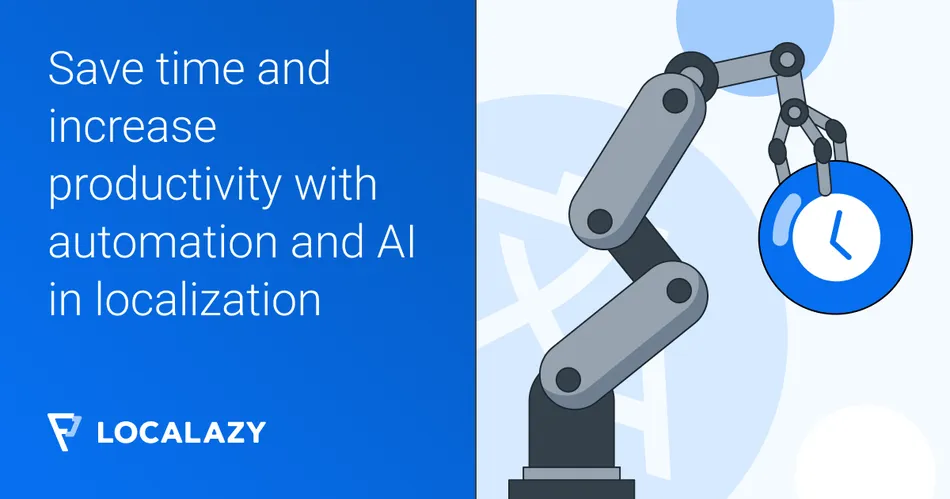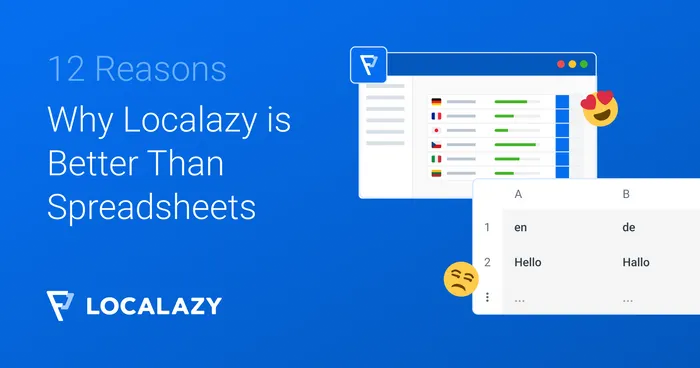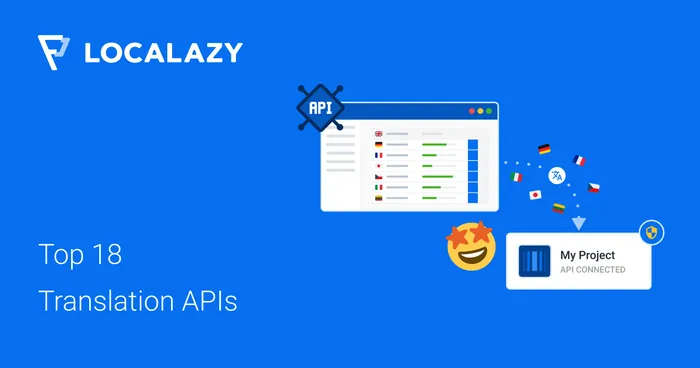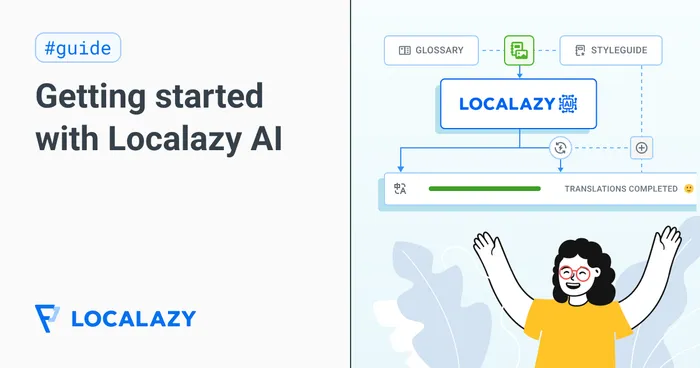People want authentic conversations. They want to hear brands address them in their language. Localizing content into their native tongue is one of the ways to achieve this level of clear and compelling communication.
74% of customers say that they would be more likely to buy from a business for a second time if they received customer support in their native language. 📞 Localized customer support and a generally personalized experience are achievable if you use a well-researched localization strategy and automation. Automation not only keeps your workflow pipelines free, but it also makes your teams more productive.
Here at Localazy, we make automation easy to implement with our features. Developers, managers, and translators alike can benefit from automation to speed up their work processes while they focus on tasks that deserve their attention. Today, we’re talking about automation and productivity from the lens of localization. But first, let’s focus on the localization part.
🔮 The growing need for l10n in 2025 🔗
Every business wanting to expand globally learns in the process that localization is a must. That’s why the need for it keeps increasing: the localization services provider market, which was estimated at USD 49.6 billion in 2024, is expected to rise to USD 96.3 billion by 2033, at a CAGR of 7.6%.
When you consider expanding to new markets, you should know that you’re about to approach people who share different cultures, backgrounds, and languages. Most importantly, you’re communicating with people who share different perspectives about what you consider the best products, best branding elements, and best marketing practices.

With localization, you take into account every aspect of expanding into a new market, from cultural distinctions to customer habits and natives’ buying psychology. It means you’ll adapt everything, from your website and/or mobile app to software and multimedia content, so it resonates with local audiences.
When you prioritize localization, you're on your way to crossing all language barriers and connecting with customers on a deeper level, nurturing these relationships and turning them into loyal customers. 🤝
When it's time to expand to new markets, keep in mind that you're communicating with people who share different perspectives about products, branding elements and best marketing practices
To win the hearts of customers, you need a localization-first expansion approach, and companies that devote time and resources to it are better poised to thrive. However, we must mention that localization is time-consuming, but automating processes and tasks can shorten it without depleting your team’s productivity.
❔ Did you know Localazy allows you to set up Automations that translate and pass your translations from one stage to the other on autopilot. Read more on this here
🪄 How automation increases productivity 🔗
Digital product teams are slowly learning to integrate automation into their processes to be more efficient and productive. Your team can benefit from it too. Automation helps in various aspects of the localization process, minimizing time-consuming manual tasks and freeing up time for strategic decision-making and creative work.
With automation-powered tools, your teams can:
- 🧪 Extract and process content,
- 🧳 translate and adapt it for different markets,
- 👌 and keep consistency across multiple languages.
In localization, automation can be applied in multiple stages of localization, including the content extraction phase and file conversions. For example, tools powered by AI can scan and identify translatable text within digital products.🕵️
If done manually, localization takes a lot of work, which often delays launches in new markets. Now, by combining machine translation, artificial intelligence (AI), and natural language processing (NLP) technologies, localization teams can reach a satisfactory level of automation that helps them lower time-to-market for multilingual updates.

🤖 Discover more about making content automation a true partner for your localization team in our Bridging the Gap podcast episode with Paul Bratslavsky, Developer Advocate at Strapi.
💡 5 benefits of automation tools for l10n teams 🔗
Automation tools are transforming localization by removing bottlenecks, improving output, and enabling scalability. Both Translation Management Systems (TMSs) and Computer-Aided Translation (CAT) help automate tasks of the localization process to speed up launches to new markets. However, the most significant improvements in the localization process come from AI-enabled workflows that could involve using large language models (LLMs) to rewrite UI copy in context, or running automated quality checks with real-time model-in-the-loop scoring.
Some systems can even adapt content tone or formality dynamically based on locale or user persona. Basically, the number of manual tasks can be reduced even further. Based on our experience driving localization wins for brands worldwide, here are five major benefits automation brings to the table:
1. Reduces localization errors 🔗
Manual processes often lead to inconsistencies in structure, phrasing, or formatting that distort meaning at the local level. Automation minimizes these risks by enforcing standardized formatting, tone of voice, and using real-time validation tools to catch issues early.
Advanced systems go further by using AI to spot tone mismatches, flag unlocalized terms, and ensure UI strings don't render incorrectly across layouts. Combined with automated Linguistic QA (LQA) and context-aware checks, this drastically reduces rework and preserves the integrity of your messaging across markets.
📖 Related read: Top 9 UX translation problems (and how to solve them)
2. Sets teams for maximum productivity 🔗
Cloud-based TMS platforms like Localazy centralize translations in one location, supporting you throughout the process by enabling notifications, comments, and instant project updates. This keeps all team members and stakeholders connected. Also, with deep integrations via CLI, API, and plugins (Figma, Strapi, Webflow, Zapier, and others), translations can be triggered as part of builds, content publication, or design updates.
You can add intelligent Automations that detect new strings, fire off pre-translations, and forward them to translators for review. Meanwhile, defined roles and automated notifications keep translators, reviewers, developers, and managers synced without meetings or chaos.
The result? Your team can collaborate on meaningful, creative localization tasks without worrying about technical, tool-switching, and administrative chores while avoiding disorganization and chaos. You’re able to browse through translations, version changes, and order translations fast.

3. Achieves higher quality, accuracy, and consistency 🔗
CAT tools play an important role in automating localization thanks to their translation memory, terminology management, glossaries, and style guides. They make it easier to keep consistent terminology, higher accuracy, and better translation quality. ✅
Translators can then focus on creative localization tasks instead of repetitive ones, using context-based tools to uphold branding and stylistic consistency globally. The outcome? Accurate, culturally-adapted translations that make brands appear local. At the end of the day, successful and effective localization relies on details, such as using local language nuances, and automation makes time for it.
4. Frees up time and distributes resources better 🔗
Automation in localization takes care of inefficient time-consuming tasks - from initial translation drafts to manual reviews. This leaves time and other resources to be distributed to impactful work. Especially when it comes to workflow management. Automations get rid of the need for manual task distribution, prevent delays, and save manhours.
As a result, there will be more budget you can spend on professional translators, proofreaders, and developing your brand. 💸 You can go from on a budget to resourceful, and save money for other aspects of your brand development so you can grow rapidly. All this is possible when you use the right tech with a high level of automation.
Automations and context tools like glossaries, translation memories and style guides are a powerful combination that increase accuracy, reduce errors and allow team members to focus on creative localization tasks while ditching time-consuming repetitive chores
5. Makes scaling to new markets easier 🔗
When we talk about localization, we’re talking about a tool that will help you get your brand loved by foreign markets. 🌐 We’re talking about powering your scaling efforts from day one so that you can add new languages to your products/services and enter new markets without much fuss as you grow.
Scaling used to mean duplicated effort each time you added a new language to your product: copying strings, re-exporting files, rebriefing translators. Now, with automations, adding a new language becomes a configuration task, not a rewrite.
The beauty of automated localization workflows lies in effortless scalability. 📈 Need to expand your Spanish launch into Portuguese? Update site navigation labels from English straight into right-to-left Arabic? Chances are, any changes and additions take just clicks rather than resource-draining manual work after you’ve set an automated localization workflow.

🔎 How can automation improve accuracy? 🔗
Accurate and consistent translations are vital for businesses that want to succeed in international markets. To achieve this, localization teams can turn to automation to improve translation accuracy and keep a consistent language across assets.
Here’s when TMSs come into play. They are equipped with:
- Error-flagging features 🚨
- Context-providing features 📖
- Intelligent suggestive algorithms 🦾
- Backlogs to keep track of all translated versions 🗂️
They make precise and error-free translations much easier to get. Automation-powered tools can efficiently handle repetitive and time-consuming tasks, making daily schedules more fun and productive. As a result, businesses can achieve faster time-to-market and respond to updates and feedback quickly.

The power of AI-driven translation tech 🔗
AI-driven translation tech is evolving fast. See, after advanced Neural Machine Translation (NMT) reached a professional level of development, serving as a time-saving partner for translators, the industry received new tools like LLMs, which can now assist translators in maintaining both quality and volume in their work.
LLMs can be fine-tuned on brand tone, glossary, and linguistic features you want to focus on while expanding to new markets. You can also benefit from AI-driven variant generations (e.g., formal/informal tone, UK/US English,) among other things. Here are some obvious benefits it presents:
🚄 Fast translations
Ingesting large amounts of text trains advanced neural networks to map ideas between languages intuitively. Now AI translates in minutes what takes people hours. Increased processing speed means faster translations and major time and budget savings. While the produced translations might not have a satisfactory quality for you, the faster they’re produced, the faster your team can review and finish them.
📝 Better and more accurate first drafts
AI models can deeply absorb the use of grammatical rules in target languages and produce first drafts of a higher quality. It’s worth noting that AI’s first drafts can be less awkward compared to human drafts. Not to mention that AI has no translator’s block.
🔠 Terminology consistency
Diligently referencing context and glossaries during drafting, AI consistently respects company terminology and brand voice. Furthermore, the tech can now easily integrate with live terminology APIs or shared termbases. 🗣️ This ensures uniform global messaging aligned with guidelines and avoids outdated or brand-inconsistent translations.
But aren't automated translations low quality? Not if you keep the right balance. Much like autonomous vehicles still need human attention, AI translation excels with a person who keeps their hands on the wheel from time to time. And most importantly, it can learn from its errors. For instance, a workflow that uses AI can look like this: MT or LLM first drafts → linguists review → AI learns from edits.
Company terminology and brand voice are kept consistent by AI. If we feed it with translators' insights, its output can be useful as an initial draft to be later polished by a human
AI produces better initial drafts when fed with insights from the translators. Otherwise, it’ll lead to generic and incorrect translations. When used correctly, it learns how we translate ideas between languages, and then it produces better translations.
Together, this augmented translation approach achieves accuracy and articulation that traditional methods can’t easily reach. Blending the translator's passion with the processing power of AI creates excellent localized assets.

🤖 Risks of automation & AI in localization 🔗
Even with all the progress in AI, translators and localization teams are still needed. But using this tech comes with some risks as well. While these tools can assist human translators, they can't fully replace their judgment, cultural awareness, or domain expertise. Here are three of the biggest risks to keep in mind:
1. Quality issues 🔗
AI-generated translations often need extensive human review (especially for legal, medical, technical, or UX-critical content). Even with large training datasets, AI still struggles with nuance, tone, and proper formatting in low-resource languages or right-to-left (RTL) scripts. Overreliance without QA can lead to inaccuracies that damage trust or create compliance issues.
2. Biased translations 🔗
Algorithms lack a human perspective. 🤖 AI learns from the data it’s trained on. That means it can reflect and amplify cultural biases, political inaccuracies, or outdated assumptions. Unlike professional translators who are briefed on the target audience and context, AI lacks the ability to judge what's appropriate or offensive. This is especially risky when translating content for sensitive or regulated industries.
3. Hallucinations and misinterpretations 🔗
AI can generate confident-sounding translations that are factually incorrect, known as “hallucinations.” These errors are not only awkward, but they can also mislead users or violate accuracy standards too. Without proper human review or automated QA layers, these risks can easily slip into production.
But while these are considerable challenges that arise with the use of AI and automation in localization, there is another pressing one that can be more alarming than a bad translation: data security. 🔐
4. Data privacy and security risks 🔗
When using cloud-based AI tools, content is often processed on external servers. If you're sending confidential legal docs or unpublished UI copy through these pipelines, you’re potentially exposing sensitive information. In regulated markets, that can mean violations of GDPR, HIPAA, or the EU AI Act.
Remember that when using AI, you’re uploading your sensitive data to Big Tech’s clouds. You could be passing highly sensitive information to be translated, and in the case of data breaches and unauthorized access, that information could end up in the wrong hands and compromise your or your clients' reputation.
📚 Related read: Safeguarding the privacy of your AI-translated project: What you need to know
Digital product teams should adopt strong security measures and encryption protocols to protect user data and intellectual property. Compliance with privacy regulations and data protection laws in different markets is imperative to avoid legal repercussions. Furthermore, some other measures might include:
- 🗃️ Secure file transfer protocols to protect shared data
- 🔓 Use multi-factor authentication and encrypt data at rest and in transit
- 👷♀️ Conduct regular security audits to identify and fix vulnerabilities
- 🖥️ Use on-prem or private translation engines for high-sensitivity content
- 🕵️ Apply redaction filters to mask private or regulated information before processing
- ✅ Vet vendors for SOC 2, ISO 27001, or AI Act compliance
While risks will always be present, by taking some of these measures, localization teams can have some level of protection when using automation and AI to improve translation quality and productivity in the localization process.
🎙️ Curious about ISO 27001 and data security? Listen to our podcast episode with cybersecurity expert Ferry Haris and Localazy CEO Václav Hodek to learn how certification protects your business

👀 The future of automation in l10n 🔗
AI empowers remarkable text translations today. However, studying cross-disciplinary leaps in voice recognition, computer vision, and generative AI, among others, hints at a future with localization solutions of a science-fiction level. Imagine:
- 📸 Images that instantly display localized text overlays, visible only to users in specific regions.
- 💬 AI-generated content that adapts tone, language, and phrasing based on cultural or demographic signals.
- 🗺️ Websites that automatically rearrange layout, directionality, and content structure based on the user’s locale.
And that just covers consumer translations. On the workflow side, we could have translation models retrain themselves based on how your brand language evolves. Monitoring systems will catch textual inconsistencies across markets in real time, flagging off-brand or outdated phrases before they go live.
As these systems get smarter, localization will shift from a manual process to a responsive, intelligent layer of global product delivery. The line between human-crafted and machine-generated localization will get harder to see. Eventually, even experts may struggle to distinguish machine versus human-generated localization.
📚 Recommended read: Translation technology: Exploring the pros and cons of AI translation
🛠️ How to prepare your team for automation adoption 🔗
The speed of adaptation says a lot about your business growth. And this is no different when it comes to automation and AI. You need to adapt your team slowly so that when change becomes mandatory, you don’t instantly shift to new tech within a day. Here are some things you can do to speed up this process.
😰 Address their fears
Be honest about how AI helps do repetitive work, so they can pursue more creative, valuable tasks. Calm fears that jobs are at risk. Make it clear that everyone stays crucial.
👂 Involve them early on
Ask which manual tasks slow them down. Let them test automation tools that solve their real pain points. Early involvement builds ownership and reduces resistance.
✍️ Run hands-on training
Don’t just announce new tools, but teach them and mentor your team on using them. Walk through real workflows using automation so the team feels confident, not confused.

🫵 Share real-life examples
Show examples of successful automation applications. Whether stats show quicker translations or reviews, before-and-after data convinces. Momentum removes uncertainty over positive impact.
📌 Related read: Inside Genspark: A real test in cross-channel localization with AI agents
🏅 Recognize their efforts
From trying updated processes to mastering new systems, reward cooperation openly. Reinforce willingness to evolve together towards efficiency. Appreciation fuels team spirit and triumphs over reluctance.
📌 Final thoughts 🔗
As AI, automation, and smarter content systems evolve, localization is becoming faster, more accurate, and deeply integrated into how global products are built and scaled. For teams aiming to reach new markets without slowing down, automation is the foundation for excellent work.
At Localazy, we help you localize without the typical chaos. Our powerful TMS is completely web-based and has been used by large brands worldwide to expand into global markets. Coupled with our CLI and the Localazy API, speed and simplicity are guaranteed in all your l10n workflows while your content remains up-to-date. Sign up today and test it yourself for free.




